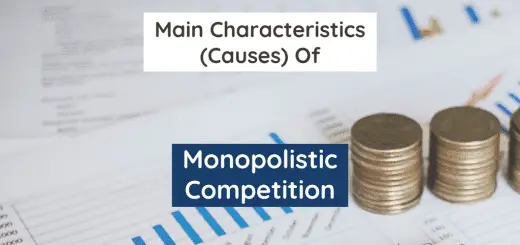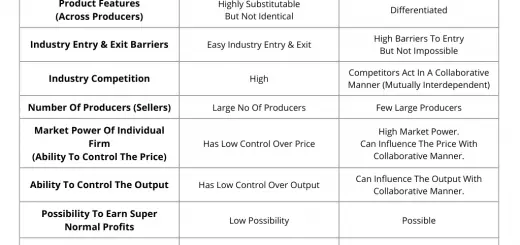Monopolistic Competition: Overview, Definition, & Features
Overview and Definition of Monopolistic Competition
Monopolistic competition is a market structure where many firms offer products or services that are highly similar, highly substitutable, but not identical. There is a large number of producers/sellers in a monopolistic competition market. Barriers to entry and exit are low which results in high competition in the market.
An individual firm has a low power to control or influence the price and output. Each firm operates independently (no room for a monopoly).
The difference between price and marginal cost is considered a mark-up. Monopolistic competition has a product mark-up, the price is always greater than the marginal cost. There is no mark-up in a perfect competition structure because the price is equal to marginal cost but the mark-up is available in monopolistic competition.
Monopolistic Competition in Short Run and Long Run
The firms can get the benefit from a supernormal profit in the short run. But sooner the competitors will also produce similar products due to fewer barriers to entry. Hence in the long term, the supernormal profit will be converted into normal profit.
Features (Charastoristics) of Monopolistic Competition
Following are the Features (Charastoristics) of a Monopolistic Market,
1. A Large Number of Producers (Sellers)
There are large numbers of firms in a monopolistic competition market. Unlike monopoly or oligopoly markets, consumers have a vast variety of choices.
2. Barriers to Entry & Exit Are Low
New entrants can enter easily as the barriers to entry is very low. The initial investment, regulatory terms, patent restrictions, and risk factors are very low. Many new corporates can and willing to compete in the market.
3. Products are Highly Similar, Highly Substitutable, But Not Identical
Firms that operate in a monopolistic competition market have very similar and highly substitutable products but are not identical. The shoe industry is a good example. There are many types of shoes with slightly different styles and quality levels.
4. Competition is High
Since there are very less barriers to entry, the monopolistic competition market has many rivels. The industry competition is high. This makes one or a couple of firms take entire control of the market.
5. The Market Power of Individual Firm is Very Low (None)
An individual firm is not capable to have any significant market power. The individual firm has very low or no market power.
6. Less Possibility for Economies of Scale
It is hard for a firm to achieve economies of scale due to the competition. But if few firms merge then it is possible to reach economies of scale.
The firm can benefit from cost advantages when reaching economies of scale. There is an optimum production output level where the firm can produce with the minimum marginal cost. Read the below article to find more information about Economies of Scale,
7. The Individual Firm Cannot Influence the Market Output or Price
An individual firm can not influence the output or price of the market. The output and price depend on the market as a whole, not on individual firms or groups of firms.
8. Supernormal Profits in the Short Term and Then Normal Profits in the Long Term
There is a certain possibility for a firm in monopolistic competition to make supernormal profits if they can fulfill a niche gap in the market. As an example, in the mobile phone production industry, if one company may create a new product with a unique design and technology, the firm will benefit from a supernormal profit.
But sooner the competitors will also produce similar mobile devices so that in the long term, the supernormal profit will be converted into normal profit.
Can A Firm Experience Economies of Scale in Monopolistic Competition?
It is hard for a firm to achieve economies of scale due to the high competition in a monopolistic competition market. But if few firms merge then it is possible to reach economies of scale due to the combined market share.
The firm can benefit from cost advantages when reaching economies of scale. There is an optimum production output level where the firm can produce with the minimum marginal cost. Read the below article to find more information about Economies of Scale,
Read More:
Market Structures
Monopolistic Competition
- Main Characteristics / Causes of Monopolistic Competition
- Real Examples of Monopolistic Competition (in USA, Canada, World)
- Advantages and Disadvantages of Monopolistic Competition
Monopoly Market
- Definition, Examples, and Characteristics of Monopoly Market
- Real Examples of Monopoly Market (in the USA, Canada, Australia, World)
- Important Characteristics / Causes of Monopoly Market
- Advantages and Disadvantages of Monopoly Market
Oligopoly Market
- Definition, Types, and Characteristics of Oligopoly Market
- Real Examples of Oligopoly Market (in the USA, Canada, World)
- Seven Important Characteristics of Oligopoly Market
- Advantages and Disadvantages of Oligopoly Market
Perfect Competition


